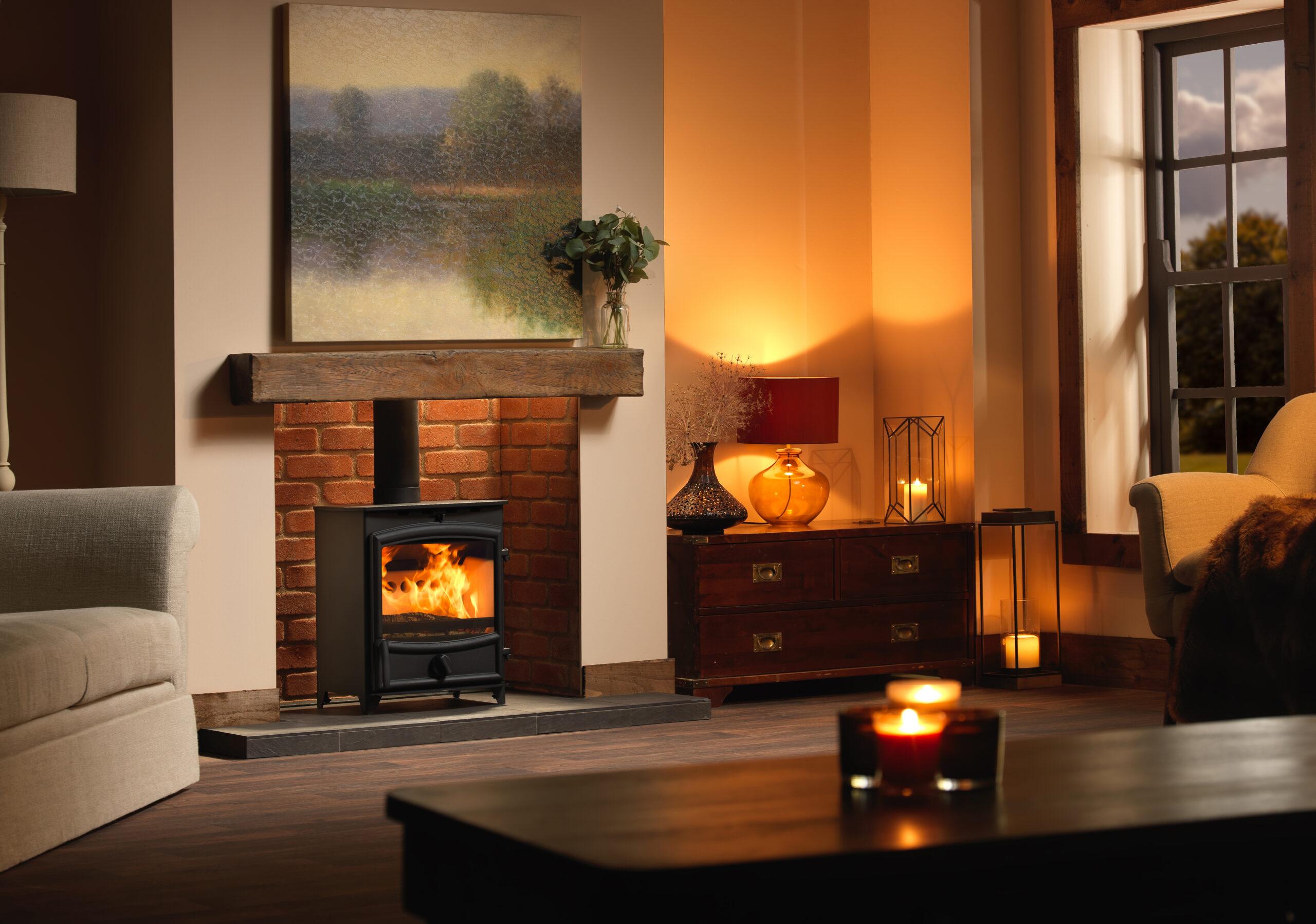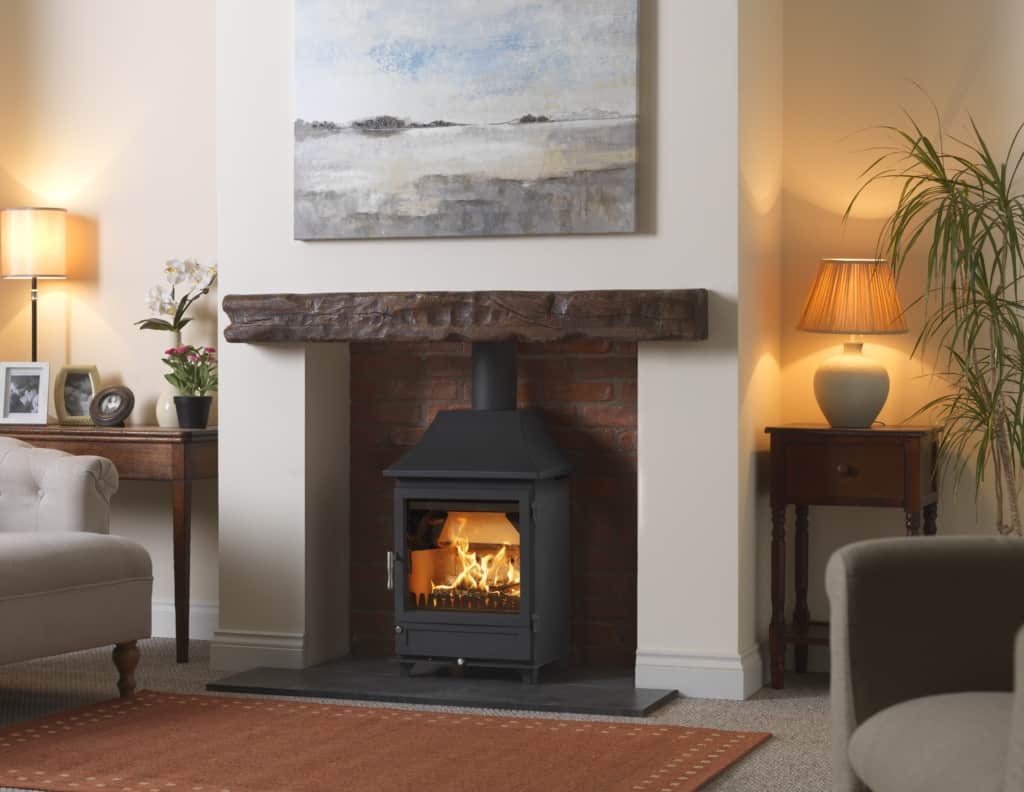We continue to invest significantly in our range of fires. Our wood-burning stoves are no exception. All our stoves are clearSkies and Ecodesign compliant, meaning you can be confident that you are warming your home in a clean and sustainable way.

Our Managing Director, Peter Mintoft, has provided a few answers to questions we are sometimes asked by people in the trade and more technically inquisitive customers regarding our fires.
.
- How do you construct a fireplace that sits between rooms to heat them both?
.
Double-sided stoves and premium gas fires are available with fire-viewing windows on both sides, enabling installation into a partition wall between rooms. They may be cassette-type built-in fireboxes or, more commonly, freestanding units. The key is to create a chamber between the rooms in question, with the flue pipe or chimney rising as directly above the chamber as possible.
For masonry construction, appropriate load-bearing lintels will be required above the chamber. Stoves can produce a huge amount of heat, so if using stud construction, serious consideration needs to be given to heat effects. Timber above the stove or fire is a risk, so non-combustible metal stud materials, plus properly rated heat-proof boards, are strongly recommended.
Open fires can also be installed in this way, but open fires are very inefficient and smoky and should be exchanged for a modern closed stove for financial fuel costs and environmental and practical reasons.
.
- If someone wants to place a fire/wood-burning stove in an unconventional place in their home, how would this affect the practicalities of the flue/gas/construction etc? Where would you suggest?
A wood burner can be sited in several places in the home, and modern freestanding stoves, plus twin-wall metal flue systems, allow fires to be placed where it was thought to be virtually impossible or certainly uneconomical up until a few years ago. UK fireplaces are typically on outside walls or party walls, but in other parts of the world, masonry stoves and fireplaces are built into the centre of the home for better efficiency and heat retention within the building.
Wherever you consider placing a stove, consider the flue system and keep it as straight as possible with good overall height for the best efficiency of operation and safety. Common placements for a stove are in a living room, kitchen, or conservatory.
Whilst it is possible to place a stove somewhere unusual, such as beneath a staircase, in a bedroom or in other situations, the limitation might be clearances to combustible materials or getting a practical flue pipe run above it.
Gas fires and stoves are available with balanced flues, which can go straight through a wall to the outside of a property. While they need a gas supply pipe laid in, they do not always require a flue pipe to rise above the stove like a conventional flue version.

.
- What preparations/construction needs to be done to have a fire/wood-burning stove outside on a terrace or in the garden?
Outdoor fires are becoming more popular, and safety must be the main consideration. The obvious points are keeping a safe distance from combustible materials to prevent the spread of fire and carefully considering the sensible selection of materials surrounding the fireplace.
Contain the fire in a robust, 100% non-combustible way with stone, refractories, or steel and keep a large, safe distance from your property or any timber garden buildings. A less obvious consideration is the gases produced by combustion and keeping any smoke away from areas of human occupation.
Combustion products contain highly toxic carbon monoxide (CO), chemical compounds, and dusty particulates. Simple outdoor devices such as charcoal barbecues cannot safely be taken into enclosed areas due to the CO in the combustion gases, and the same applies to any kind of outdoor fire. Stay safe and keep any fires well away from enclosed spaces, especially young children, the elderly, or the infirm.
.
- Aside from the fire/wood-burning stove itself, what other materials help create the aesthetics of a fireplace?
A plethora of materials can be used in and around a fireplace. The main consideration, dependent on the positioning, is heat resistance, as invariably, any fire or wood burner will put out a significant amount of radiant and convected heat. Reclaimed brick or other hard masonry materials can give a classic traditional look even in a new build or recent restoration, and when combined with cast iron components, a period look can be re-created.
More sophisticated and, therefore, usually more expensive materials, such as marble or more consistent micro marble, are always popular, but the resin content of micro marbles allows for reduced heat resistance.
Tiles are becoming more popular in fireplaces once again, with ceramics being finished in a wide range of surface finishes, from riven slate to smooth metallic. A notable current trend is for a rustic or distressed timber finish beam (preferably non-combustible material) above a chamber with a stove recessed inside. Often, the chamber will be lined with stone-edge tiles, giving a rustic mosaic-style patterning.

.
- What tips can you offer people about choosing a fire/wood-burning stove and getting the aesthetics right?
5kW output wood burners are by far the most popular UK sizing, offering good, powerful heating capacity without permanent air bricks being required so long as enough air supply is available.
The styling of wood burners or fires have moved well away from the elaborate cast iron or brass clad designs of yesteryear to a leaner era of design. Stoves with a classic look are still widely available but usually much more refined and often with a much larger air washed fire viewing window than previously available.
European stoves are a growth area with much more modern, neat, and functional designs, typically incorporating very large glass windows. Current trends are for plainer, more neutral colours and have moved away from elaborate decoration and patterning, but ultimately, individual choice rules. A fire and fireplace for your individual style of décor and property can definitely be accommodated, whether it be classic Victoriana or ultra-cool modern chic.








